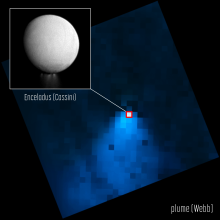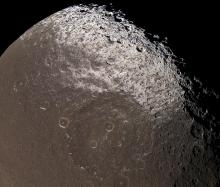You are here
Saturn's Moons
Titan: Smog World
Surrounded by a thick atmosphere that's topped by orange smog, and with a landscape that in some ways resembles Earth, Titan is one of the solar system's most intriguing moons.
Titan's frigid atmosphere is about 60 percent denser than Earth's at the surface, and clouds float across the sky. A global haze of organic molecules tops the atmosphere, so it was almost impossible to study the surface until the Cassini spacecraft, which carries instruments that can peer through the haze, arrived at Saturn in 2004.
| Titan | Enceladus | Iapetus | Mimas | |
|---|---|---|---|---|
| Discovery | 1655, Christiaan Huygens | 1789, William Herschel | 1671, Jean Dominique Cassini | 1789, William Herschel |
| Diameter | 3,200 miles 5,150 km |
310 miles 500 km |
893 miles 1,436 km |
2,985 miles 4,806 km |
| Distance from Saturn | 745,000 miles 1.2 million km |
147,812 miles 238,020 km |
2.2 million miles 3.6 million km |
115,210 miles 185,520 km |
| Orbital Period | 16 days | 1.4 days | 79.3 days | 22 hours, 37 minutes |
Scientists had expected to find large seas or oceans of liquid methane, but Cassini found that there may be only a few small bodies of liquid. The Huygens probe, which parachuted through Titan's atmosphere in early 2005, photographed a landscape that, in some ways, is similar to Earth's, with possible drainage channels carved into hillsides. Huygens' instruments also found a thin layer of ice coating the surface at its landing site.
Titan's surface consists of rock and ices. Volcanoes may belch methane into the atmosphere, contributing to the moon's smog layer.
Tracking Titan's Temperature
As the Huygens probe parachuted through the atmosphere of Saturn's moon Titan in January 2005, it took the first direct measurements of temperatures, wind speeds, and the atmosphere's composition. Yet it sampled only one small region on one day. To fully understand Titan's complex atmosphere, scientists must study the entire moon, and repeat their observations to see how it changes over time.
In support of that goal, McDonald Observatory astronomer Laurence Trafton and his colleagues monitored Titan around the time of the Huygens landing from the Infrared Telescope Facility atop Hawaii's Mauna Kea. Their observations looked at the abundance of an organic molecule that could help yield clues to the atmosphere of the early Earth, which Titan's present-day atmosphere may resemble. The observations also can serve as a comparison to those made by Huygens, helping scientists calibrate the probe's discoveries.
Trafton was using a Texas-built spectrograph, TEXES, to study the molecule cyanoacetylene. This organic molecule is of particular interest because it contains nitrogen, which is one of the ingredients of amino acids, which are some of the "building blocks" of life. The early Earth probably contained similar molecules, so studying them on Titan could yield new information about the atmospheric conditions that led to life on Earth. The molecule also provides a look at temperatures in Titan's upper atmosphere across the entire moon. The Texas researchers found that the temperatures were a little lower than expected. But their observations, which covered primarily the southern hemisphere of Titan, were similar to those of the Voyager 2 spacecraft, which studied Titan's northern hemisphere when it flew past Saturn more than two decades ago.
Their data will form part of the overall picture of Titan that is emerging from Huygens and the Cassini orbiter, with support from astronomers at McDonald and other observatories on Earth.
Enceladus
Enceladus, a small ball of ice and rock, is the most reflective surface in the solar system: it reflects 99 percent of the visible sunlight that strikes it back into space. Cassini discovered that Enceladus has a tenuous atmosphere, which is resupplied by water vapor and water ice leaking from parallel cracks in the crust near its south pole (shown in blue in this color-enhanced Cassini image, right).
Most of this material falls back onto the surface as clean ice, which is highly reflective. In essence, Enceladus re-polishes its surface with material from its interior. Because of the moon's weak gravity, however, much of the material escapes Enceladus and supplies fresh ice to Saturn's outermost ring.
Iapetus
One side of Iapetus is as bright as snow, while the other is almost as dark as charcoal (left). The leading hemisphere may pick up particles of dark material that are blasted off the surface of another moon by impacts with meteorites, or the material may be ice that bubbled up from below the surface and was darkened by exposure to radiation. A ridge up to eight miles (13 km) high circles the equator, making Iapetus look a bit like a walnut. There is no clear explanation for what created the ridge.
Mimas
Mimas is nicknamed the "Death Star Moon" because a circular crater about one-third of the moon's diameter makes it resemble the big battle stations from the "Star Wars" movies. The crater (top center, above) formed when an asteroid or comet slammed into Mimas. The impact was so powerful that it almost blasted the moon to bits. Had the collision been just a little more powerful, it would have pulverized Mimas, forming a new ring around Saturn. Instead, Mimas appears to sweep out a wide gap in the rings, as some of the ring particles march in step with the Death Star Moon.
| 1. Albiorix 2. Atlas 3. Calypso 4. Daphnis 5. Dione 6. Enceladus 7. Epimetheus 8. Erriapo 9. Helene 10. Hyperion 11. Iapetus 12. Ijiraq |
13. Janus 14. Kiviuq 15. Mimas 16. Methone 17. Mundilfari 18. Paaliaq 19. Narvi 20. Pan 21. Pallene 22. Pandora 23. Phoebe 24. Polydeuces |
25. Prometheus 26. Rhea 27. Siarnaq 28. Skadi 29. Suttung 30. Tarvos 31. Telesto 32. Tethys 33. Thrym 34. Titan 35. Ymir 36. S/2004 S7 |
37. S/2004 S8 38. S/2004 S9 39. S/2004 S10 40. S/2004 S11 41. S/2004 S12 42. S/2004 S13 43. S/2004 S14 44. S/2004 S15 45. S/2004 S16 46. S/2004 S17 47. S/2004 S18 |
Teacher Copies
Request a free copy of The Solar System or Beyond the Solar System for your classroom. Bulk copies are available for $1.50 each in quantities of 30 or more. Shipping is included. Call 512-471-5285 for orders of 30 or more.
 The Astro Guides for the Solar System and Beyond the Solar System are supported by the National Aeronautics and Space Administration under Grant Nos. NNG04G131G and NAG5-13147, respectively.
The Astro Guides for the Solar System and Beyond the Solar System are supported by the National Aeronautics and Space Administration under Grant Nos. NNG04G131G and NAG5-13147, respectively.





